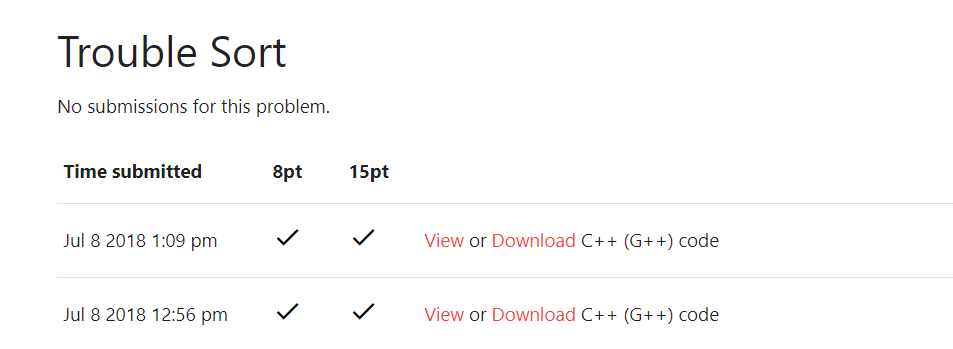這是Google的第二題,這題跟上一題比起來簡易了許多,主要使用排序功能。
我國文造詣真的很差,打篇文章都筆寫程式還久了有點慘...請見諒。
原題目
Code Jam仔細研究了經典的泡沫排序法,然而發現了一個新的變種。
正常的泡沫排序法是檢查相鄰的數字,如果左邊大於現在的數字,則交換。但是我們的算法是三個相鄰的數字,如果左邊數字大於右邊數字,則翻轉整組,因此我們將"三個一組泡沫排序"命名為Trouble Sort。
例如,L = 5 6 6 4 3,Trouble Sort排序如下:
輸入的第一行T測試筆數。每個測試筆數有兩行組成:一行整數N,列表中的大小,然後另一行帶有個N個整數V。
輸出每筆資料,包含Case #x: y,其中x是測試筆數編號,如果是正確排序y輸出OK,如果不是則輸出第一個錯誤的索引(從0開始)。
1 <= Ť <= 100 。
1 <= V <= pow(10,9)。
測資1: 3 <= N <=100 每個測試集10秒。
測資2: 3 <= N <= pow(10,5) 每個測試集20秒。
記憶體限制:1GB。
輸入:
2
5
5 6 8 4 3
3
8 9 7
輸出:
Case #1: OK
Case #2: 1
做了STL版本和指標版本,測試看Google測資輸出會不會有問題,很幸運的Google的都可以使用。
1.STL版本
#include <iostream>
#include <vector>
#include <algorithm>
#include "math.h"
using namespace std;
// 輸出
void Print(const int& index, const int& result)
{
if (result == -1)
{
cout << "Case #" << index + 1 << ": OK" << endl;
}
else
{
cout << "Case #" << index + 1 << ": " << result << endl;
}
}
// num1: 奇數數列
// num1: 偶數數列
int Compute(vector<int>& num1, vector<int>& num2)
{
// 直接對奇數和偶數排序,可換成自己實作排序(O(N^2)應該是不能)。
sort(num1.begin(), num1.end());
sort(num2.begin(), num2.end());
int nowNum = num1[0];
// 檢查奇數索引和偶數索引兩個相鄰,是否是非遞減,若不是則回傳索引位置。
// 依照num2的大小來取得索引, 所以要乘上2才是原本索引位置。
// 為何回傳上一個索引位置? 因我們是用上一個數字來比較,反之用下一個比較則傳回當下索引
for (size_t index = 0; index < num2.size(); index++)
{
if (nowNum > num1[index])
{
return (index << 1) - 1;
}
if (num1[index] > num2[index])
{
return (index << 1);
}
nowNum = num2[index];
}
// num1可能會比num2多一個數字,若小於上一個數字則回傳上一個索引位置。
// 索引位置num1大小乘上2 - 2為最大索引(因為num2少1所以要多減1),回傳上一個,所以減3
if (num1.size() > num2.size()
&& nowNum > num1[num1.size() - 1])
{
return (num1.size() << 1) - 3;
}
return -1;
}
// 輸入
void Input()
{
//筆數
int testCount = 0;
while (cin >> testCount)
{
for (int count = 0; count < testCount; count++)
{
// 數列長度
int numSize;
cin >> numSize;
vector<int> num1(static_cast<unsigned int>(ceil(numSize / 2.0)));
vector<int> num2(static_cast<unsigned int>(floor(numSize / 2.0)));
// 輸入奇偶數列
for (size_t index = 0; index < num2.size(); index++)
{
cin >> num1[index] >> num2[index];
}
// 奇數可能多一個
if (num1.size() > num2.size())
{
cin >> num1[num1.size() - 1];
}
int result = Compute(num1, num2);
Print(count, result);
}
}
}
int main()
{
Input();
return 0;
}
2.指標版本
#include <iostream>
#include <algorithm>
#include "math.h"
using namespace std;
// 輸出
void Print(const int& index, const int& result)
{
if (result == -1)
{
cout << "Case #" << index + 1 << ": OK" << endl;
}
else
{
cout << "Case #" << index + 1 << ": " << result << endl;
}
}
// num1: 奇數數列
// num1: 偶數數列
// num1Size: num1大小
// num2Size: num2大小
int Compute(int*& num1, int*& num2, unsigned int num1Size, unsigned int num2Size)
{
// 直接對奇數和偶數排序,可換成自己實作排序(O(N^2)應該是不能)。
sort(num1, num1 + num1Size);
sort(num2, num2 + num2Size);
int nowNum = num1[0];
// 檢查奇數索引和偶數索引兩個相鄰,是否是非遞減,若不是則回傳索引位置。
// 依照num2的大小來取得索引, 所以要乘上2才是原本索引位置。
// 檢查到則回傳上一個索引位置,因我們是用上一個數字來比較,反之用下一個比較則傳回當下索引
for (unsigned int index = 0; index < num2Size; index++)
{
if (nowNum > num1[index])
{
return (index << 1) - 1;
}
if (num1[index] > num2[index])
{
return (index << 1);
}
nowNum = num2[index];
}
// num1可能會比num2多一個數字,若小於上一個數字則回傳上一個索引位置。
// 索引位置num1大小乘上2 - 2為最大索引(因為num2少1所以要多減1),回傳上一個,所以減3
if (num1Size > num2Size
&& nowNum > num1[num1Size - 1])
{
return (num1Size << 1) - 3;
}
return -1;
}
// 刪除指標
template <class T>
inline void DeleteArray(T& ptr)
{
delete[] ptr;
ptr = nullptr;
}
// 輸入
void Input()
{
//筆數
int testCount = 0;
while (cin >> testCount)
{
for (int count = 0; count < testCount; count++)
{
// 數列長度
int numSize;
cin >> numSize;
unsigned int num1Size = static_cast<unsigned int>(ceil(numSize / 2.0));
unsigned int num2Size = static_cast<unsigned int>(floor(numSize / 2.0));
int* num1 = new int[num1Size];
int* num2 = new int[num2Size];
// 輸入奇偶數列
for (unsigned int index = 0; index < num2Size; index++)
{
cin >> num1[index] >> num2[index];
}
// 奇數可能多一個
if (num1Size > num2Size)
{
cin >> num1[num2Size - 1];
}
int result = Compute(num1, num2);
DeleteArray(num1);
DeleteArray(num2);
Print(count, result);
}
}
}
int main()
{
Input();
return 0;
}

以上兩個版本看起來其實大同小異,對於我來說指標版本方便在可以控制神麼時候要釋放記憶體,這裡在result後就釋放掉記憶體了,vector部分則要等到Print跑完,如果認知有誤或還有更好算法希望大大們指導提供。

這題的解法和大大類似,將奇數項和偶數項分開排序,並偷懶用 STL 的 sort,您程式內提到的實作排序 O(n²),小弟就是血淋淋的例子,大 Case 會超時。![]()
#include <stdio.h>
#include <stdlib.h>
#include <algorithm>
#include <vector>
using namespace std;
int main(void)
{
int c = 0;
int testcase;
scanf("%d", &testcase);
while (testcase--)
{
int N, T;
scanf("%d", &N);
vector<int> nums1; //奇數陣列
vector<int> nums2; //偶數陣列
//讀取陣列
nums1.reserve(N / 2);
nums2.reserve(N / 2);
for (int i = 0; i < N; i++)
{
scanf("%d", &T);
if (i % 2 == 0)
nums1.push_back(T);
else
nums2.push_back(T);
}
//排序
sort(nums1.begin(), nums1.end());
sort(nums2.begin(), nums2.end());
//檢查排序是否成功
int curr, prev = -1;
int index = -1;
for (int i = 0; i < N; i++)
{
curr = i % 2 == 0 ? nums1[i / 2] : nums2[i / 2];
if (prev > curr)
{
index = i - 1;
break;
}
prev = curr;
}
//印出結果
if (index == -1)
{
printf("Case #%d: OK\n", c + 1);
}
else
{
printf("Case #%d: %d\n", c + 1, index);
}
c++;
}
//system("pause");
return 0;
}
這個我的方式也很大大一樣,
奇數和偶數拆開來排序,
雖然我排序也直接用函數,但大小CASE都會過不知道為什麼![]()
#會先輸入總共有幾題
questionCount = int(input())
#跑迴圈
for index in range(1,questionCount + 1):
#這邊會輸入陣列的行數,
#我們複製一個暫存的空陣列,等等裝排序後的資料
tempArr = [None] * int(input())
'''
這邊把輸入的內容用split切成陣列,
之後用map做陣列的尋訪,把每個值都轉成數字,
最後再用list把它轉換成陣列
'''
arr = list(map(int, input().split(" ")))
#把奇數排列後的資料裝到tempArr的奇數位置
tempArr[0::2] = sorted(arr[0::2])
#把偶數排列後的資料裝到tempArr的偶數位置
tempArr[1::2] = sorted(arr[1::2])
#印出的function
def printStatus(status):
print("Case #" + str(index) + ": " + status)
#這邊設定預設結果為OK,如果再迴圈內沒比較到錯誤的就印出OK
status = "OK"
#去檢查我們剛剛用來放奇偶數各自排列的暫存陣列
for i in range(len(tempArr)-1):
#如果這次的數字比下一個數字大代表沒有排好
if(tempArr[i]>tempArr[i+1]):
#所以把錯誤的位置放到status中跳出迴圈
status = str(i)
break
#把結果印出來
printStatus(status)